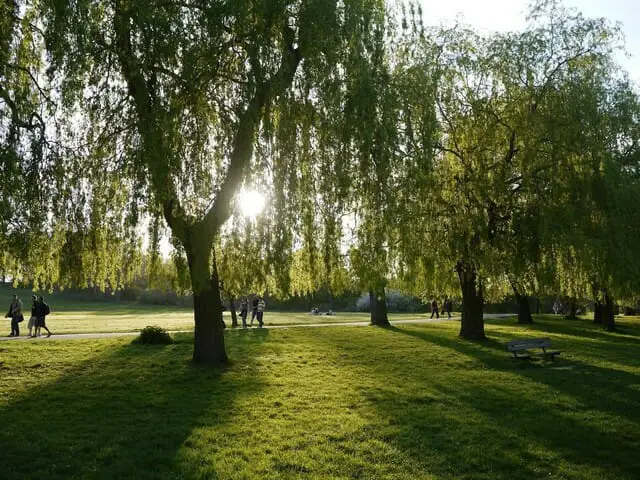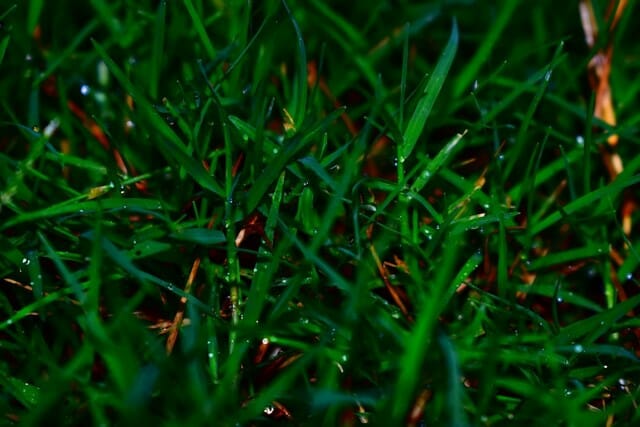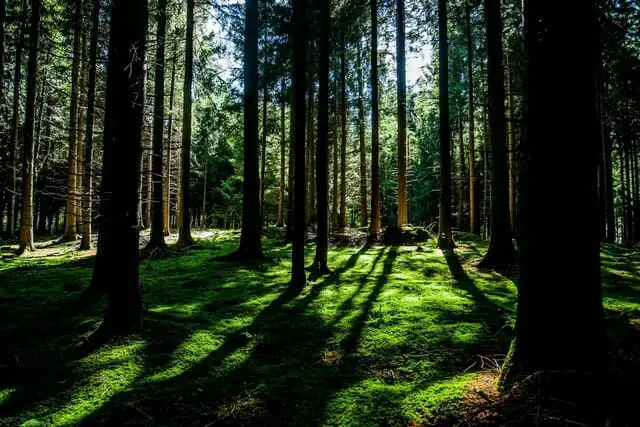Last Updated on May 18, 2022 by Grow with Bovees
A shade-tolerant grass is all you need to deal with the lack of sunshine on your lawn.
Plant the best grass for shade, and watch your lawn transform into the greenest outdoor space in the neighborhood.
Unsure what to go for? These are the best lawn grasses for shade:
- Bluegrass.
- Fescue.
- Ryegrass.
- St. Augustine.
- Zoysia.
- Centipede.

However, before we look at these in more detail, understanding the different shades will help you choose the ideal grass.

Know Your Shade
Determine the amount of shade your grass will get based on this guide:
- Full: Shade covers the grass the entire day.
- Partial: Receives some sunlight during the day.
- Light or heavy: Determined by the tree canopy’s depth.
- Dappled: Small rays of sunlight penetrate the shady tree branches and leaves.
Whether you’re planting grass on a new lawn, resodding or reseeding, knowing how many hours of direct sunlight your grass will get in a day allows you to place certain types of grass in certain locations.
Shade from trees, shrubs and walls prevents the grass from getting sunlight.
Grass needs sunlight to help process its nutrients, making it vital for your grass to grow and be healthy.
What Kind of Grass Grows Under Trees?
All shade-resistant grasses grow under trees, but fescue has a higher chance of growing to maturity. Fescue and many of its variations have deeper roots, enabling them to compete with the tree’s roots for water and nutrients, even without much sunlight. Even if the soil quality is poor or has less nitrogen, fescue won’t just survive, but thrive.
What Kind of Grass Grows Best in the Shade?
First, you must know if your area is good for warm-season or cool-season grass, then find the best grass with the highest shade tolerance:
- Cool-season grass: Grows well where the spring and fall temperatures range between 650F and 800F.
- Warm-season grass: Thrives where summer temperatures are between 750F and 900F.
Note: Cool-season grasses have a higher shade-tolerance compared to warm-season grasses.
Therefore, if you live in a place where both can thrive in a shaded garden, pick a cool-season grass!
The Best Cool-Season Grasses for Shade
Sabre III Poa Trivialis Bluegrass
The bluegrass species with the highest shade tolerance is Sabre III Poa trivialis.
It’s specially produced through selective breeding of other species. This gives it a combination of superior qualities from the combined grass species—one of them being high shade tolerance. Four hours of partial or dappled sunlight are more than enough for it to thrive.
In a cool climate, this grass is grown as a permanent lawn cover, while in warm weather, it’s best overseeded through winter.
Fine Fescue Grass
Out of all the cool-season grasses, fine fescue has the highest shade tolerance. Its deep roots help the grass fight for water and other nutrients against tree and shrub roots. It only needs four hours per day of partial or dappled sunlight to grow.
The five variants of fine fescues in order of decreasing shade tolerance are:
- Chewings fescue.
- Slender creeping red fescue.
- Strong creeping red fescue.
- Hard fescue.
- Sheep fescue.
Perennial Ryegrass
The shade-tolerant ryegrass species is perennial. It only needs four to five hours of partial sun daily to grow and flourish.
It grows quickly, tolerates wear better than the other cool-season grasses, and can survive high traffic areas, like schools and parks.

The Best Warm-Season Grasses for Shade
St. Augustine
St. Augustine grass is the most shade-tolerant out of all the warm-season grasses.
The cultivars to go for are:
- Seville.
- Sapphire.
- Bitter Blue.
- Palmetto.
They can survive with at least five to six hours of partial sunlight.
Zoysia
This grass needs six hours of partial daily sun To keep its thick, soft and light-green color in shades.
Shade-tolerant Zoysia cultivars to choose under this group are:
- Cavalier.
- El Toro.
- Crowne.
- Diamond.
Centipede
Even though centipede grass needs full sun to blossom, it can manage with six hours of partial sun each day.
The best shade-tolerant cultivars are:
- Oaklawn.
- Tennessee hardy.
Top Tips For Growing Grass in the Shade
Limit Lawn Traffic
Foot traffic will easily damage the already stressed grass. The lack of sufficient lighting and nutrients has weakened the grass to the extent that it won’t regrow well.
Allow More Light In
Trim the tree branches and shrubs to let more light in and extend the sunlight exposure for an increase in nutrient-absorption.
Increase The Mowing Height
The grass needs every inch of additional blade surface to capture the sun. Therefore, consider mowing the shady areas higher than normal.
If only part of the lawn gets sunlight, mow the exposed part in line with the shaded grass for an even lawn.
Combine Different Low Light Grasses
Having different shade-tolerant grasses on your lawn will ensure it survives varied climatic conditions and diseases.
This is especially useful if you live in an area with extreme summers and winters, where one grass will weaken in the summer and grow well in the winter, with its counter growing in the summer and weakening in the winter.
Restore Soil pH Balance
The soil’s pH tends to change when in the shade. This leads to the growth of weeds and ugly lawn mosses. Moss forms a slimy coating, curbing soil aeration, so be vigilant in maintaining pH balance.
If you need to increase the pH level, add some lawn lime to the soil. Reducing pH levels can be difficult, so be careful not to raise the level too much.
Don’t Use Excess Nitrogen Fertilizer
Nitrogen is essential in enhancing color, density, resisting diseases and for your shade-tolerant grass’ overall health. You should use weed and feed for lawns that suit your particular application.
But, nitrogen will cause fast vertical growth to escape the shade and reach some light. As a result, the grass will focus most of its energy on shoot growth, neglecting the roots.
If you then mow the grass, you lose a lot of the shoot, which is important for photosynthesis.
Frequently Asked Questions
How Do You Get Grass to Grow in Shade?
First, prepare the surface under the shade where you want to grow the grass. This involves checking the soil pH balance, removing weeds and adding soil where necessary.
Next, buy a good blend of quality shade-tolerant grass seed. Then plant the seeds and ensure healthy lawn maintenance for optimum grass health and growth.
When Should I Plant Grass Seed in the Shade?
The best time to plant cool-season grasses, which are more shade-tolerant, is late summer and early fall. This is when the soil temperature is optimal—between 500F and 650F.
How Do You Grow Grass in Full Shade?
The best way to grow grass in full shade is to prune the trees as much as possible to reduce the shade. If the grass is shaded due to more fixed structures, such as buildings and walls, it’s even more important to buy shade-tolerant grasses. Even then, the very best grasses need 4 to 6 hours of dappled sun per day.

Get the Best Shade Grass For Your Lawn.
Planting the best low light grass seed for your shaded lawn is important to maintaining a green, healthy lawn.
If you’re in a cold-weather region, fine fescue grass should be your first choice. For warm-season environments, St. Augustine grass seed will provide the perfect lush and green cover for your yard.

